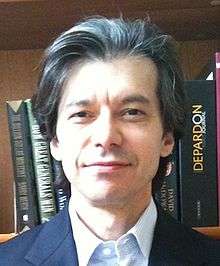Azad Bonni
| Azad Bonni | |
|---|---|
 | |
| Residence | St. Louis, Missouri |
| Nationality | Canada and United States |
| Fields | Neuroscience, cell biology and molecular biology |
| Institutions | Washington University, Harvard University |
Azad Bonni, MD, PhD is a Canadian and American neuroscientist of Kurdish origin.[1] The focus of his research is to understand the mechanisms of neuronal connectivity in the brain.[2] He is currently the Edison Professor of Neuroscience and Chairman of the Department of Neuroscience at Washington University School of Medicine.[1]
Biography and research
Azad Bonni (born in 1963) grew up in Kurdistan. In 1976, he emigrated with his family to Canada. He completed secondary school at W. D. Lowe High School in Windsor, Ontario in 1980. He enrolled at Queen's University in Kingston, Ontario, where he earned his medical degree in 1986. He specialized in neurology at McGill University and became chief neurology resident at the Montreal Neurological Institute in 1990.[3] He earned his PhD in neuroscience at Harvard University in 1996. Bonni did his PhD and postdoctoral studies in the laboratory of Michael Greenberg between 1992 and 1999,[4] where he discovered signaling mechanisms by which neurotrophic factors, including ciliary neurotrophic factor (CNTF) and neurotrophins, induce transcription and cell differentiation and survival in the nervous system.
He launched his own laboratory in the Department of Pathology at Harvard Medical School in 1999.[1] He moved to the Department of Neurobiology at Harvard Medical School in 2011. His laboratory has made seminal contributions to the study of cell-intrinsic transcriptional and ubiquitin pathways that regulate neuronal connectivity in the developing brain. In 2012, Azad Bonni was named the Edison Professor of Neuroscience and Chairman of the Department of Neuroscience at Washington University in St. Louis, Missouri.[1]
References
- 1 2 3 4 Bonni to lead anatomy and neurobiology department
- ↑ Azad Bonni, MD, PhD
- ↑ The Bonni Lab Archived April 15, 2013, at the Wayback Machine.
- ↑ Neurotree
